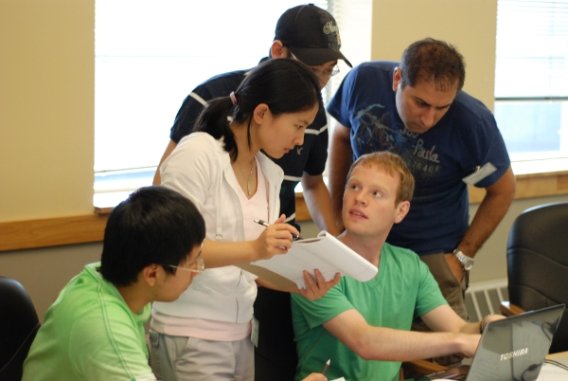History

The IMA: The Hub of Collaboration
Founded in 1982, the Institute for Mathematics and its Applications (IMA) is an NSF-funded visitors’ institute that has grown to become among the most influential math institutes in the world. Located on the University of Minnesota campus, it is one of eight NSF Mathematical Sciences Research Institutes. The IMA has no permanent faculty, but rather is a flux of visitors and postdoctoral researchers.
The IMA aims to achieve synergy between mathematics and its applications, develop transformative mathematical research through interdisciplinary exploration, strengthen and broaden the workforce that confronts pressing challenges facing science and society, and effectively communicate the role of mathematics in our world. The IMA utilizes many strategies and mechanisms to realize these goals, from its annual thematic program to hot topics workshops to seminars and public lectures.
Each year, a field of research, “thematic program,” is chosen and premier mathematicians and applied scientists work together to identify and address that field’s most critical topics and challenges. The annual program has proven to have the greatest impact on accomplishing the IMA’s mission.
The highly collaborative nature of the institute attracts more than 1,000 mathematicians and other scientists annually to visit the IMA. Collaborating at the IMA is not about just solving problems. It’s about identifying opportunities and challenges where math is the answer and where one solution can carry over to many other disciplines, from biology and psychology to astronomy and medicine and everywhere in between.
More than 200 postdoctoral candidates from around the world compete each year for two-year fellowships to work with the distinguished researchers at the IMA. The IMA’s postdoctoral program is among its greatest assets. A major goal of the IMA is to expand the talent base engaged in mathematical research applied or relevant to interdisciplinary investigations. At the IMA, postdocs receive high-level training and guidance.
The IMA is a vital component of the mathematical sciences infrastructure in the United States, and contributes to and advances the health, prosperity, and security of the nation.The IMA is located at the University of Minnesota, Twin Cities Campus, Lind Hall. It enjoys a close affiliation with the School of Mathematics, the College of Science and Engineering, and the Minnesota Center for Industrial Mathematics.
Background
The IMA was created in 1982 in response to an NSF Call for Proposals for a Mathematical Sciences Institute made in 1979. Hans Weinberger, George Sell, and Willard Miller, all math professors from within the University of Minnesota School of Mathematics, put together a proposal in which they envisioned a math institute that looked outward from the core of mathematics toward applications. Its goal was to bring mathematicians together with scientists to create new research that would have an impact on the science, as well as enrich mathematics. Under Weinberger’s leadership as the institute’s first director, the IMA quickly gained prominence as a premier national mathematical research center. It was during this time that the Industrial Advisory Panel and Participating Corporation program were established, and the IMA Volumes in Mathematics and its Applications series was launched.
When Avner Friedman became director in 1987, he pursued connections between mathematics and industry. He worked tirelessly to build contacts in industry, bringing industrial scientists to the IMA. Through his work, he demonstrated the value of mathematics in industrial applications. Numerous industrial programs were established under Friedman’s tenure, including the Industrial Problems Seminar in 1987, Industrial Postdoctoral program in 1989, the Math Modeling in Industry Workshop series, and the first hot topics workshop in 1996 on Data Mining.
The IMA’s directorship next went to Willard Miller in 1997. In the four years Miller was director, he was able to secure funding for the IMA in the first open competition for math institutes since 1979. From 1982 to 1997, the two math institutes in the country, IMA and MSRI, were routinely reviewed and renewed. Miller also oversaw the launch of the IMA Public Lecture Series in 1998.
Douglas Arnold came in as director in 2001. He oversaw a lot of improvements and expanded the IMA’s existing programs. Under his leadership, the NSF renewal in 2005 was the largest single award in the Division of Mathematical Sciences’ portfolio for several years. Arnold also added innovative new programs, like the New Directions program in 2002.
Fadil Santosa took over the directorship in 2008 with the goal of making the IMA even more outward-looking and to expand the institute’s educational programs. This included an interdisciplinary Research Undergraduate Experience (REU) created with Macalester College in 2009. The IMA’s international profile was increased with the establishment of the Abel Conferences in 2011 and other collaborations abroad in Canada, China, and South Korea. And to celebrate young researchers, the IMA Prize in Mathematics and its Applications was launched in 2014.